Data Assimilation and Model Calculations to Study Chemistry Climate Interaction and Solar Impact in the Polar Stratosphere (DACCS)
This project is being funded through the Deutsche Forschungsgemeinschaft (» DFG) as part of the priority programme Climate and Weather of the Sun Earth System (» CAWSES).
Data set
The 29 year data set (1979 – 2007) of stratospheric ozone from sequential assimilation of SBUV satellite ozone profile observations into the B3DCTM as described in » Kiesewetter et al., 2010, is available in NetCDF format upon request. Please contact Dr. Jan Aschmann (jan.aschmann (at) iup.physik.uni-bremen.de).
Objectives
The project DACCS will investigate the interaction between ozone and atmospheric dynamics in the polar stratosphere with the help of data assimilation of satellite ozone observations and numerical model integrations. There will be a focus on early winter ozone in the polar stratosphere and its relation to meteorological conditions later during winter and total ozone during spring. Recently, it has been shown that there exists an unexpectedly strong correlation between polar stratospheric ozone in autumn and early winter and total ozone at high latitudes during spring. Similarly, there exists a close correlation between early winter ozone and meteorological conditions later during winter and spring. The mechanisms for this relation are currently unclear. Moreover, there is some evidence for a possible large solar impact on polar stratospheric ozone in early winter. However, the only available long term observations of polar stratospheric ozone during autumn are from observations of the SBUV(/2) satellite instruments, which are limited, because SBUV(/2) as UV/visible sounders cannot observe during twilight and polar night. We will thus perform a reconstruction of high latitude ozone from SBUV(/2) observations and other satellites (SAGE I/II, GOME and » SCIAMACHY) with the help of data assimilation. The ozone observations will be analyzed and interpreted with meteorological re-analyses.
Background
Stratospheric ozone has shown large decreases over past decades at high latitudes over both hemispheres. The large ozone losses over the southern hemisphere high latitudes in spring in the Antarctic Ozone Hole have been clearly attributed to chemical ozone depletion as a result of anthropogenic emissions of chlorine and bromine containing substances, most importantly the chlorofluorocarbons (CFCs) and halons (WMO, 2003). Similarly, large losses of stratospheric ozone have been observed in the Arctic during individual winters. However, there exists a large inter-annual variability in springtime total ozone over the Arctic as a result of inter-annual changes in the meteorological conditions during northern hemisphere winter. Understanding the processes behind the inter-annual variability of polar ozone is important in order to predict if and when polar ozone will recover under the influence of a changing climate. It is now well accepted that the inter-annual variability of total ozone during spring in the Arctic is closely related to the activity of planetary waves during winter, propagating from the troposphere into the stratosphere. Years with higher than average wave activity during winter go along with warmer stratospheric temperatures and higher than average total ozone during spring, and vice versa (Newman et al., 2001). Planetary waves influence stratospheric ozone in three ways: (a) by modulating the poleward and downward transport of ozone into high latitudes through the wave driven Brewer-Dobson circulation, (b) by affecting mixing between polar and mid-latitude air and (c) indirectly through changes in stratospheric temperature which affects polar chemical ozone depletion. Years with low wave activity show a slowdown in the Brewer-Dobson circulation and consequently colder polar stratospheric temperatures which enables chemical ozone depletion in the lower polar stratosphere. E.g., Weber et al. (2003) have shown that there exists a close correlation between the activity of planetary waves in a given winter (expressed by the upward component of the Eliassen- Palm flux through the mid-latitude lower stratosphere) and total ozone in spring for both hemispheres. Because the planetary waves originate from the troposphere it is sometimes more or less tacitly assumed that the inter-annual variability in the stratosphere is controlled by the troposphere below.
It thus came as a surprise when recently Kawa et al. (Atmos. Chem. Phys., 5, 1655-1663, 2005) have shown that a close correlation exists between total ozone over the Arctic during spring and the level of ozone in the Arctic polar vortex during the previous autumn:
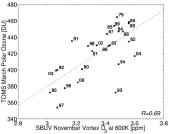
|
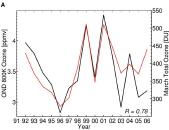
|
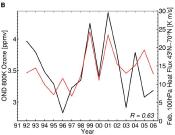
|
| Recently we have shown that a similar correlation exists for ozone sonde observations at the Arctic site of Ny-Alesund (79°N, 12°E) |
Moreover, there is a correlation between early winter ozone and the wave activity (expressed by the EP flux or eddy heat flux) during the following February. The mechanisms for the observed correlations are currently not clear.
Possible impact on the surface climate
In addition to being relevant for understanding and predicting the evolution of the Arctic ozone layer, these results may also be relevant for the surface climate, through a coupling with the Arctic oscillation. We find that for years with Arctic total ozone above average (> 410 DU), there is a higher probability of finding the Arctic Oscillation (AO) in a strong negative phase, while for years with total ozone below average (< 410 DU) there is a higher probability of finding the AO in a strong positive phase:
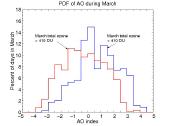
|
||
Assimilation of satellite ozone observations
Part of the existing uncertainties are due to a lack of long term data sets of stratospheric ozone at high latitudes during autumn and winter. The only long time series (covering at least two solar cycles) comes from observations of the Solar Backscatter Ultra-Violet (SBUV and SBUV/2) satellite instruments. However, observations of SBUV(/2) as with all UV/visible instruments require sunlight and are thus not possible at high latitudes during winter at twilight and polar night. Kawa et al. (2005) have therefore used SBUV(/2) observations that were taken in the sunlit parts of the polar vortex to derive polar vortex averages. A further step into that direction will be the assimilation of SBUV(/2) and other satellite observations into a numerical chemical transport model. The model will then effectively fill the regions not directly assessable through the observations through advection of ozone. The long photochemical lifetime of ozone in the high latitude stratosphere and the absence of photochemical changes during darkness will allow a propagation of ozone information from sunlit into dark regions of the polar stratosphere.

|
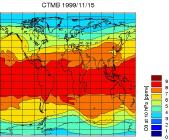
|
|
As an example, the two figures above show the ozone mixing ratio at 10 hPa on 15 November 1999 from SBUV observations and from our chemical transport model (CTMB). Note that the model, which is free running here (i.e., not contrained here by any observations) captures well the structure of the ozone field (e.g., the tongue of ozone rich air advected over China) but has an overall bias due to the use of a simple parameterized ozone chemistry here. We thus expect that the assimilation of SBUV(/2) observations (and possibly other satellite data) into the model will lead to a high quality reconstructed ozone field.
References
- Kawa, R. S., P. A. Newman, R. S. Stolarski, and R. M. Bevilacqua, Fall votex ozone as a predictor of springtime total ozone at high northern latitudes, Atmos. Chem. Phys., 5, 1655-1663, 2005
- Sinnhuber et al., Large decadal scale changes of polar ozone suggest solar influence, Atmos. Chem. Phys., 6, 1835-1841, 2006
- Weber, M., S. Dohmse, F. Wittrock, A. Richter, B.-M. Sinnhuber, and J. P. Burrows, Dynamical control of NH and SH winter/spring total ozone from GOME observations 1995-2002, Geophys. Res. Lett., 30, 1583, doi:10.1029/2002GL016799, 2003